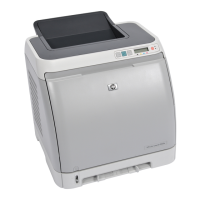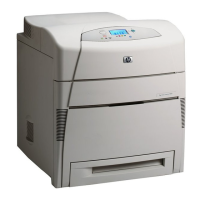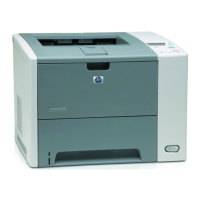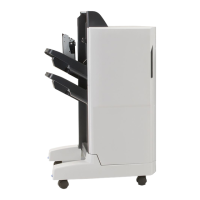52 Theory of operation C9148-90909
Introduction
This chapter presents an overview of the relationships between major components in the MFP. It
also provides a general description of the following:
● mechanical systems (for example, the flatbed intake fan)
● electronic circuits (for example, the scanner controller circuit)
● sensors (for example, the document-detect sensor)
Overview
Scanning a document consists of three main processes. First, the document is transported
through the ADF or manually placed on the glass. Second, the document is illuminated and the
light is captured (the document-exposure process). Third, the captured light is converted to a
digital signal and sent to the base printer for output (image processing).
When the copy processor board (CPB) receives a scan command from the control panel, it
sends the command to the scanner controller board, which initiates and controls the scanning
process.
These main components are used in the scanning process.
● scanner controller board (controls the scanning process and communication with the CPB)
● automatic document feeder (ADF) (transports the source document)
● optical unit (holds the scanning lamp and charged couple device [CCD])
● scanning lamp (exposes the document)
● charged-couple device (CCD) driver PCB (converts reflected light to digital RGB signals for
final output)
Document transportation process
The ADF receives a signal from the scanner control PCB and begins to transport the document.
A sensor in the ADF detects the document in the input tray. The ADF picks up the document.
Then, the document travels through the ADF toward the flatbed. A second sensor in the ADF
confirms that the document was successfully transported through the ADF. After the scanning
process the document is transported to the ADF output.
Document exposure system
● The source document is loaded through the ADF.
After receiving the scan command from the copy processor board, the scanner controller
board sends a signal to the scanning lamp in the optical unit. The lamp illuminates the
document as the ADF passes the document past the optical unit (the optical unit does not
move). A calibration strip mounted under the glass allows automatic document registration
during the exposer process. The light is reflected from the scanning plate and is sent (by way
of three mirrors and a lens) to the CCD driver PCB for image processing. The source
document is deposited in the ADF output.
● The source document is manually placed on the glass.
After receiving the scan command from the copy processor board, the scanner controller
sends a signal to the scanning lamp. The lamp illuminates the document as the optical-unit
motor moves the optical unit down the length of the document. The light is reflected from the
scanning plate and is sent (by way of three mirrors and a lens) to the CCD driver PCB for
image processing. When the scanning process is complete, the optical unit returns to its
home position.

